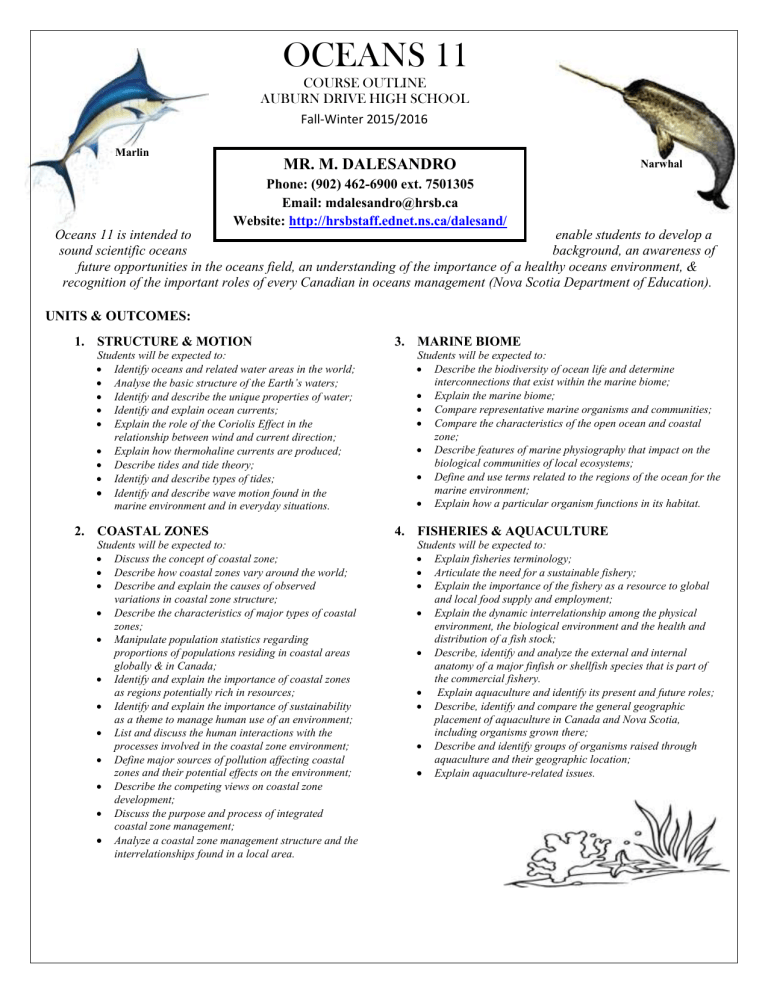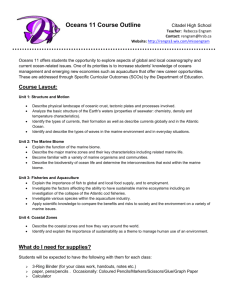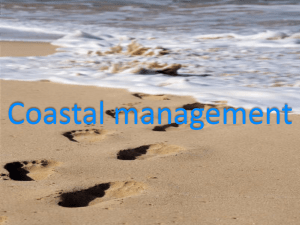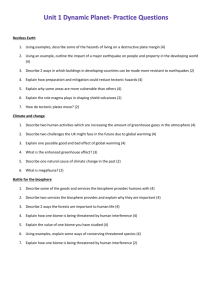Course Outline - Nova Scotia Department of Education

OCEANS 11
COURSE OUTLINE
AUBURN DRIVE HIGH SCHOOL
Fall-Winter 2015/2016
Marlin
MR. M. DALESANDRO
Phone: (902) 462-6900 ext. 7501305
Narwhal
Email: mdalesandro@hrsb.ca
Oceans 11 is intended to
Website: http://hrsbstaff.ednet.ns.ca/dalesand/ enable students to develop a sound scientific oceans background, an awareness of future opportunities in the oceans field, an understanding of the importance of a healthy oceans environment, & recognition of the important roles of every Canadian in oceans management (Nova Scotia Department of Education).
UNITS & OUTCOMES:
1.
STRUCTURE & MOTION
Students will be expected to:
Identify oceans and related water areas in the world;
Analyse the basic structure of the Earth’s waters;
Identify and describe the unique properties of water;
Identify and explain ocean currents;
Explain the role of the Coriolis Effect in the
relationship between wind and current direction;
Explain how thermohaline currents are produced;
Describe tides and tide theory;
Identify and describe types of tides;
Identify and describe wave motion found in the marine environment and in everyday situations.
2.
COASTAL ZONES
Students will be expected to:
Discuss the concept of coastal zone;
Describe how coastal zones vary around the world;
Describe and explain the causes of observed variations in coastal zone structure;
Describe the characteristics of major types of coastal zones;
Manipulate population statistics regarding proportions of populations residing in coastal areas globally & in Canada;
Identify and explain the importance of coastal zones as regions potentially rich in resources;
Identify and explain the importance of sustainability as a theme to manage human use of an environment;
List and discuss the human interactions with the processes involved in the coastal zone environment;
Define major sources of pollution affecting coastal zones and their potential effects on the environment;
Describe the competing views on coastal zone development;
Discuss the purpose and process of integrated coastal zone management;
Analyze a coastal zone management structure and the interrelationships found in a local area.
3.
MARINE BIOME
Students will be expected to:
Describe the biodiversity of ocean life and determine
interconnections that exist within the marine biome;
Explain the marine biome;
Compare representative marine organisms and communities;
Compare the characteristics of the open ocean and coastal zone;
Describe features of marine physiography that impact on the biological communities of local ecosystems;
Define and use terms related to the regions of the ocean for the marine environment;
Explain how a particular organism functions in its habitat.
4.
FISHERIES & AQUACULTURE
Students will be expected to:
Explain fisheries terminology;
Articulate the need for a sustainable fishery;
Explain the importance of the fishery as a resource to global and local food supply and employment;
Explain the dynamic interrelationship among the physical environment, the biological environment and the health and distribution of a fish stock;
Describe, identify and analyze the external and internal anatomy of a major finfish or shellfish species that is part of the commercial fishery.
Explain aquaculture and identify its present and future roles;
Describe, identify and compare the general geographic placement of aquaculture in Canada and Nova Scotia, including organisms grown there;
Describe and identify groups of organisms raised through aquaculture and their geographic location;
Explain aquaculture-related issues.
COURSE ASSESSMENT UNITS
STRUCTURE & MOTION 25%
COASTAL ZONES 25%
MARINE BIOME 25%
FISHERIES & AQUACULTURE 25%
The above represents 80% of your final grade.
The final exam is worth 20%.
Required Materials
Binder, loose-leaf paper, pen or pencil.
Calculator may be used at times
Extra Help
Extra help is usually available during lunch each day (12:05 – 12:45). Additional times by appointment.
Students are encouraged to attend extra help to complete the missed labs, finish assignments, discuss course material, assignments, tests, missed classes, etc.
Online Resources
Website: check for assignments, homework, and the due dates of assignments and upcoming tests and quizzes @ http://hrsbstaff.ednet.ns.ca/dalesand/
Late Assignment Practice
Assignments must be completed by the given due date, usually one week after the assignment is given. A final deadline , one week after the due date (two weeks after the assignment is given), will apply to all assignments.
Assignments may not be accepted after this time.
Important Notes
If absent, it is the student’s responsibility to get all missed work upon return to class.
Extra credit work will not be given.
There will be no rewrites on tests or quizzes.
Plagiarism & Cheating
Plagiarism is taking the thoughts and/or writing of others and presenting them as your own. Cheating is sharing information during a test, exam or individual assignment. All cheating and plagiarism will result in a mark of zero for student(s) involved.
Tests & Quizzes
There will be one test and one quiz per unit. All tests and quizzes will be given with at least three days notice. There will be no “pop” (surprise) quizzes.
Final Exam
A final exam covering all course outcomes will be held during the formal examination period. The final exam is worth 20% of the course grade.









